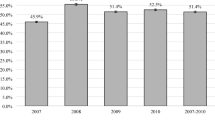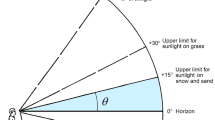Abstract
Aims
To study student's knowledge of the effects of sunlight on the eyes, as well as their sun protective behaviours.
Methods
In total, 40 students aged 13–18 years were surveyed in South Australia, during August–September 2004, using a standardized previously used survey. Scores were calculated regarding knowledge about ultraviolet light, sunlight effects on eyes, as well as eye and body protection. Risk factor scores were produced for each student. The data were analysed by the analysis of variance (ANOVA), as well as the Cochran–Mantel–Haenszel methods. Results were compared to the same survey conducted in 1995 in Queensland Australia.
Results
This group demonstrated a moderate level of knowledge, similar to the 1995 survey. Students in the older age groups demonstrated significantly higher knowledge. The majority of students (74%) owned a pair of sunglasses; however, 44.5% almost never wore their glasses. The reported frequency of wearing sunglasses was significantly related to advertising, believing sunglasses protect the eyes, as well as personal, family, and peer attitudes towards wearing sunglasses.
Conclusion
The results of our survey suggest no significant change in knowledge and behaviours of students, compared to the 1995 survey. We feel it is imperative that adolescents be made more aware of the damaging effects of sunlight and the benefits of eye protection. Health promotion campaigns should target the youth and consider that as a group, they are significantly influenced by the media, peers, and family attitudes.
Similar content being viewed by others
Log in or create a free account to read this content
Gain free access to this article, as well as selected content from this journal and more on nature.com
or
References
Delcourt C, Carriere I, Ponton-Sanchez A, Lacroux A, Covacho MJ, Papoz L . Light exposure and the risk of cortical, nuclear and posterior subcapsular cataracts: the Pathologies Oculaires Liees a l'age (POLA) study. Arch Ophthalmol 2000; 118: 385–392.
Threlfall T, English DR . Sun exposure and pterygium of the eye: a dose–response curve. Am J Ophthalmol 1999; 128: 280–287.
Quandt SA, Elmore RC, Arcury TA, Norton D . Eye symptoms and use of eye protection among seasonal and migrant farm-workers. South Med J 2001; 94: 603–607.
Luthra R, Nemesure BB, Wu SY, Xie SH, Leske MC, Barbados Eye Studies Group. Frequency and risk factors for pterygium in the Barbados eye study. Arch Ophthalmol 2001; 119: 1827–1832.
Gazzard G, Saw SM, Farook M, Koh D, Widjaja D, Chia SE et al. Pterygium in Indonesia: prevalence, severity and risk factors. Br J Ophthalmol 2002; 86: 1341–1346.
McCarty CA, Fu CL, Taylor HR . Epidemiology of pterygium in Victoria, Australia. Br J Ophthalmol 2000; 84: 289–292.
McCarty C, Taylor HR . A review of the epidemiologic evidence linking ultraviolet radiation and cataracts. Dev Ophthalmol 2002; 35: 21–31.
Lim R, Mitchell P, Cummings RG . Cataract associations with pinguecula and pterygium: the Blue Mountains eye study. Am J Ophthalmol 1998; 126: 717–719.
Panchapakesan J, Hourihan F, Mitchel P . Prevalence of pterygium and pinguecula: the Blue Mountains eye study. Aust N Z J Ophthalmol 1998; 26 (Suppl): S2–S5.
Taylor HR . Aetiology of climatic droplet keratopathy and pterygium. Br J Ophthalmol 1980; 64: 154–163.
Lee GA, Williams G, Hirst LW, Green AC . Risk factors in the development of ocular surface epithelial dysplasia. Ophthalmology 1994; 101: 360–364.
Tucker MA, Shields JA, Hartge P, Augsburger J, Hoover RN, Fraumeni Jr JF . Sunlight exposure as a risk factor for intraocular malignant melanoma. N Engl J Med 1985; 313: 789–792.
Cruickshanks K, Klein R, Klein BE, Nondal DM . Sunlight and the 5-year incidence of early age-related maculopathy: the Beaver Dam eye study. Arch Ophthalmol 2001; 119: 246–250.
Delcourt C, Carriere I, Ponton-Sanchez A, Fourrey S, Lacroux A, Papoz L, POLA Study Group. Light exposure and the risk of age-related macular degeneration: the pathologies oculaires liees a l'age (POLA) study. Arch Ophthalmol 2001; 119: 1463–1468.
Coombs BD, Sharples KJ, Cooke KR, Skegg DCG, Elwood JM . Variation and covariates of the number of benign nevia in adolescents. Am J Epidemiol 1992; 36: 344–345.
Harrison SL, Maclennan R, Apeare R, Wronski I . Sun exposure and melanocytic naevi in young Australian children. Lancet 1994; 344: 1529–1532.
Lee GA, Hirst LW, Sheehan M . Knowledge of sunlight effects on the eyes and protective behaviors in adolescents. Ophthal Epidemiol 1999; 6: 171–180.
Lee GA, Hirst LW, Sheehan M . Knowledge of sunlight effects on the eyes and protective behaviors in the general community. Ophthal Epidemiol 1994; 1: 67–84.
Mackenzie FD, Hirst LW, Battistutta D, Green A . Risk analysis in the development of pterygia. Ophthalmology 1992; 99: 1056–1061.
The Cancer Council of South Australia. Skin cancer rates continue to climb. News Release 2003; 1: 1–5.
Bechmann K, Conor P . SunSmart Evaluation Report No. 1. Sun protection practices among South Australian school students 1999: results of the 1999 ASSAD survey conducted in South Australia. Anti-Cancer Foundation of South Australia 2001, pp 13–26.
Javitt JC, Taylor HR . Absorptive lenses: the need for ocular protection. In: Meltzer DW, Isbey EK, Miller D (eds) Clinical Modules for Ophthalmologists. American Academy of Ophthalmology: San Francisco, 1991 Vol 9, module 3.
Acknowledgements
We thank Lisa Yelland, Department of Public Health, University of Adelaide, for the kind help.
Author information
Authors and Affiliations
Corresponding author
Rights and permissions
About this article
Cite this article
Pakrou, N., Casson, R., Fung, S. et al. South Australian adolescent ophthalmic sun protective behaviours. Eye 22, 808–814 (2008). https://doi.org/10.1038/sj.eye.6702619
Received:
Revised:
Accepted:
Published:
Issue date:
DOI: https://doi.org/10.1038/sj.eye.6702619



